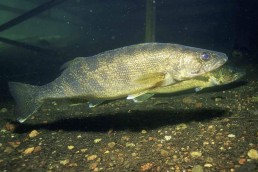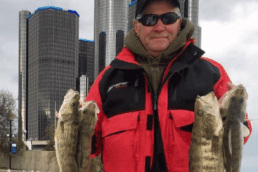Crankbaits, Breaklines and Great Lakes Walleyes
SHARE THIS POST
Learning to target Great Lakes walleyes where they live
It’s no secret Great Lakes walleyes roam large sections of these bodies of water. Some waterways within the massive freshwater system with huge bays, such as Lake Huron’s Saginaw Bay and Lake Michigan’s Little Bay de Noc, as examples, can spoil an angler because of the high density of fish that reside there year-round.
But there’s more than just a handful of places in the Great Lakes walleyes wander. What’s unknown to many is nearly every river and stream that flows in the Great Lakes will, at one time or another, see rogue schools of fish feeding where water roils into the big lakes. The problem? Knowing exactly when the fish will drift through.
Crank into schools of ‘eyes
By the end of each March, when the ice breaks on the Great Lakes walleyes will be there. In early spring, these marble-eyed inhabitants start congregating, gathering for procreation. This makes finding them a much less daunting task in these vast waterways. Troll to find and catch walleyes. In the cold water that prevails this time of year, I prefer to pull crankbaits.
Trolling crankbaits allows me to cover as much water as possible. It’s the perfect ploy for locating small schools of walleyes. But, there is more to trolling than just haphazardly pulling lures through the water column. Finding the fish, tweaking speed and placing lures perfectly within the strike zone are all imperative when it comes to catching versus just getting your lures wet.
The art of pulling crankbaits
Great Lakes walleyes can be in just about any depth of water, near river mouths, from the single digits to 50 feet and beyond. And it’s because of the diversities in depth that I pull as many lines and lures as I can. Usually with a spread of Church Tackle’s in-line planer boards and stern planers.
Planer boards allow me to pull several different lures at one time without getting tangles. They also permit me to try different depths with diverse lures. While planer boards spread my lines out, the stern planers keep lines in a direct path behind my Lund and between my planer boards. Stern planers also keep my lures in the strike zone, helping me manage the amount of line out.
But I don’t troll crankbaits just anywhere. Instead, I pull them along breaklines, making sure to get them running directly over the tips of points and through cuts unseen by the naked eye.
Using electronics to see bottom irregularities
How I see those irregularities under the surface is by using Navionics mapping, coupled with my Lowrance HDS Carbon 12. Navionics has high-definition maps of nearly every popular place Great Lakes walleyes roam. With an SD card filled with Navionics’ charts in the unit’s card reader, I can see which way I must steer my Lund well ahead of time, allowing me to get my baits on target with every pass.
Another component to catching early spring walleyes is being able to see my speed easily on the large screen of my sonar. This is because controlling speed right down to 0.10 mph is crucial when it comes to catching, instead of just fishing.
Are you enjoying this post?
You can be among the first to get the latest info on where to go, what to use and how to use it!
Don’t outrun your catch!
Sometimes slower over fast-paced is what’s needed to get bit in the frigid water. And it’s not because the walleyes don’t want to catch up to fast-paced forage, it’s because these cold-blooded fish simply can’t catch up. There bodies are the same temperature as their surroundings. When the water is barely above freezing, the fish’s muscles become rigid.
As I usually do in summer, I’ll start trolling as slowly as my lures allow. Then, I’ll start working my way faster by only 0.10 mph until I start getting bites. I give it 15 to 20 minutes before changing. Overall, speeds of .8 to 1.5 mph will be what it takes, this time of year.
Lures to put on your line for catching Great Lakes walleyes
Lures with plastic bodies wobble wider at slower speeds than those made of balsa wood (as a general rule). Two of my go-to lures that have a lot of action at slow speeds are Rapala’s Jointed Deep Husky Jerk and their Scatter Rap Deep Husky Jerk; the former in size 12 (4 3/4 inches long) diving 8 to 12 feet and the latter in size 10 (4 inches) diving 9 to 12 feet. If I need the lures to get any deeper, I’ll pull them with Sufix 832 Advanced Lead Core in 18-pound test, with a leader of 12-pound-test Berkley Trilene 100% Fluoro Leader Material.
When trolling crankbaits, I use either 10-pound-test Berkley Trilene XT (Extra Tough) or 12-pound Trilene XL (Extra Limp). Both are nearly identical in diameter, but the XL has a little more stretch to it. XL’s elasticity aids in hook ups when trolling as the lure goes farther back in the fish’s mouth. Meanwhile, the XT is good when extra abrasion resistance is a must, such as rocky areas or quagga muscle-infested waterways. No matter what crankbait I troll, I connect it to my line with a Berkley snap, not snap-swivel. A snap allows the lure the most action without the added weight of the swivel.
Here and there
As I mentioned, as soon as the ice breaks up off the Great Lakes walleyes will start showing up near river inlets. In general, the smaller males migrate in first, followed by the larger females. But the big hens may only be around for a short time, each one swimming in, laying eggs and then heading back out into the big lakes. The males, however, stick around after the main spawning, just in case a late comer swims in.
The main spawn occurs when water temperatures get into the mid-40s, and often correlates with either the full moon or new moon. Watch the environment of the waterways you fish and you can fish smack dab in the middle of the most fish.
Don’t wait
Keep your eye on the conditions as soon as the ice starts to disappear from the Great Lakes. Watch water temperatures and moon phases. Once the environment’s right, troll crankbaits behind planer boards precisely along different breaklines until you find fish. Once found, try different speeds until you get bit. You’ll be surprised at the walleyes you catch, even in the most unknown of walleye destinations.
Mark Martin is a touring walleye tournament pro and instructor with the Fishing Vacation/Schools. Check out his website at markmartins.net for more information.
Crankbaits are great for summer walleyes, too! Check out our article on cranking up dog-days walleyes.
MWO
SHARE THIS POST
Did you enjoy this post?
You can be among the first to get the latest info on where to go, what to use and how to use it!
MWO
We believe being outdoors is good. With more than 1,000 articles each year, MidWest Outdoors magazine is all about sharing outdoor experiences with you—where to go, what to use and how to use it… whether you’re close to home or on that trip of a lifetime.


